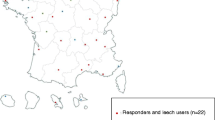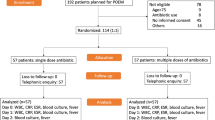Abstract
Background Medicinal leech therapy is effective in establishing venous outflow in congested flaps and replants. However, its use is also associated with infections, especially from Aeromonas species. To prevent this nosocomial infection, levofloxacin has been established as prophylaxis during leech therapy in our hospital. Objectives To study the implementation rate of a guideline, to study the effect of levofloxacin on possible Aeromonas infections, and to evaluate the financial impact of this preventive measure. Setting A retrospective analysis on all patients treated with Hirudo medicinalis between July 2007 and March 2011 was performed at the Ghent University Hospital, Belgium. Method A list of patients treated with leeches was retrieved from the pharmacy database. Patient characteristics, date of start and stop of leech therapy were collected. Data on routine diagnostic cultures during leech therapy, date and type of clinical sample, while cultivated micro-organism with antibiotic susceptibility were obtained from the laboratory database. Main outcome measure percentage implementation rate of a guideline, presence of Aeromonas infections, financial impact of levofloxacin prophylaxis. Results Fifty-one patients were treated with leeches. Forty-six (90.2 %) patients were treated according the guideline. Fourteen out of 51 patients (27.5 %) were suspected for postoperative wound infections. From them, 60 clinical samples were sent for microbiological analysis. These included exudates (26.7 %), peroperative samples (5.0 %), puncture fluid (1.7 %), blood cultures (3.3 %) or smears from burns (63.3 %). No Aeromonas species were cultivated. Comparison between period before and after implementation of levofloxacin prophylaxis revealed that levofloxacin prevents colonization or infection with Aeromonas species in relation to leech therapy. The direct cost for levofloxacin prophylaxis in the current study was 2,570 euro. Based on data obtained in a previous study, we presume that a minimum cost-saving of 20,500 euro was realised during the current study period by implementation of antimicrobial prophylaxis. Conclusions This study demonstrates successful implementation of a guideline for levofloxacin prophylaxis during leech therapy. Following its introduction, no Aeromonas species related to the use of leeches were isolated as compared to 8.5 % in the baseline period.
Similar content being viewed by others
References
Abdelgabar AM, Bhowmick BK. The return of the leech. Int J Clin Pract. 2003;57(2):103–5.
Ernst E. Born to suck–the return of the leech? Pain. 2008;137(2):235–6.
Schnabl S, Kunz C, Unglaub F, Polykandriotis E, Horch R, Dragu A. Acute postoperative infection with Aeromonas hydrophila after using medical leeches for treatment of venous congestion. Arch Orthop Trauma Surg. 2010;130:1323–8.
Whitaker IS, Elmiyeh B, Wright DJ. Hirudo medicinalis: the need for prophylactic antibiotics. Plast Reconstr Surg. 2003;112:1185–6.
Sartor C, Limouzin-Perotti F, Legré R, Casanova D, Bongrand M, Sambuc R, et al. Nosocomial infections with Aeromonas hydrophila from leeches. Clin Infect Dis. 2002;35:E1–5.
Wang EW, Warren DK, Ferris VM, Casabar E, Nussenbaum B. Leech-transmitted ciprofloxacin-resistant Aeromonas hydrophila. Arch Otolaryngol Head Neck Surg. 2011;137(2):190–3.
Mumcuoglu KY, Huberman L, Cohen R, Temper V, Adler A, Galun R, Block C. Elimination of symbiotic Aeromonas spp. from the intestinal tract of the medicinal leech, Hirudo medicinalis, using ciprofloxacin feeding. Clin Microbiol Infect. 2010;16(6):563–7.
Fenollar F, Fournier PE, Legré R. Unusual case of Aeromonas sobria cellulitis associated with the use of leeches. Eur J Clin Microbiol Infect Dis. 1999;18:72–3.
Bauters TG, Buyle FM, Verschraegen G, Vermis K, Vogelaers D, Claeys G, Robays H. Infection risk related to the use of medicinal leeches. Pharm World Sci. 2007;29(3):122–5.
Isenberg HD. In: Essential procedures for clinical microbiology. Washington DC : ASM Press, 1998. ISBN-10: 1555811256.
Graf K, Ott E, Vonberg RP, Kuehn C, Haverich A, Chaberny IF. Economic aspects of deep sternal wound infections. Euro J Cardiothorac Surg. 2009;37(4):893–6.
Weber WP, Zwahlen M, Reck S, Feder-Mengus C, Misteli H, Rosenthal R, et al. Economic burden of surgical site infections at European university hospital. Infect Control Hosp Epidemiol. 2008;29(7):623–9.
Glance LG, Stone PW, Mukamel DB, Dick AW. Increases in mortality, length of stay and cost associated with hospital-acquired infections in trauma patients. Arch Surg. 2011;146(7):794–801.
Boltz MM, Hollenbeak CS, Julian KG, Ortenzi G, Dillon PW. Hospital costs associated with surgical site infections in general and vascular surgery patients. Surgery. 2011;150(5):934–42.
Alfonso JL, Pereperez SB, Canoves JM, Martinez MM, Martinez IM, Martin-Moreno JM. Are we really seeing the total costs of surgical site infections? Wound Repair Regen. 2007;15:474–81.
Levine SM, Frangos SG, Hanna B, Colen K, Levine JP. Aeromonas septicemia after medicinal leech use following replantation of severed digits. Am J Crit Care. 2010;19(5):469–71.
AR Elyassi, Terres J, Rowshan HH. Medicinal leech therapy on head and neck patients: a review of literature and proposed protocol. Oral Surg Oral Med Oral Pathol Oral Radiol. 2013;116(3):167–72.
van Alphen NA, Gonzalez A, McKenna MC, McKenna TK, Carlsen BT, Moran SL. Ciprofloxacin-resistant Aeromonas infection following leech therapy for digit replantation: report of 2 cases. J Hand Surg Am. 2014;39(3):499–502.
Zarb P, Amadeo B, Muller A, Drapier N, Vankerckhoven V, Davey P, Goossens H. On behalf of the ESAC-3 hospital care subproject Group. Identification of targets for quality improvement in antimicrobial prescribing: the web-based ESAC Point Prevalence Survey 2009. J Antimicrob Chem. 2011;66:443–9.
Malcolm W, Nathwani D, Davey P, Cromwell T, Patton A, Reilly J, Cairns S, Bennie M. From intermittent antibiotic point prevalence surveys to quality improvement: experience in Scottish hospitals. Antimicrob Resist Infect Control. 2013;2(1):3.
Acknowledgments
We thank Jolien Maertens for excellent assistance in collecting the data and Frits Desmet for cultivating the leeches.
Funding
None.
Conflicts of interest
The authors have no conflicts of interests.
Author information
Authors and Affiliations
Corresponding author
Rights and permissions
About this article
Cite this article
Bauters, T., Buyle, F., Blot, S. et al. Prophylactic use of levofloxacin during medicinal leech therapy. Int J Clin Pharm 36, 995–999 (2014). https://doi.org/10.1007/s11096-014-9986-x
Received:
Accepted:
Published:
Issue Date:
DOI: https://doi.org/10.1007/s11096-014-9986-x




